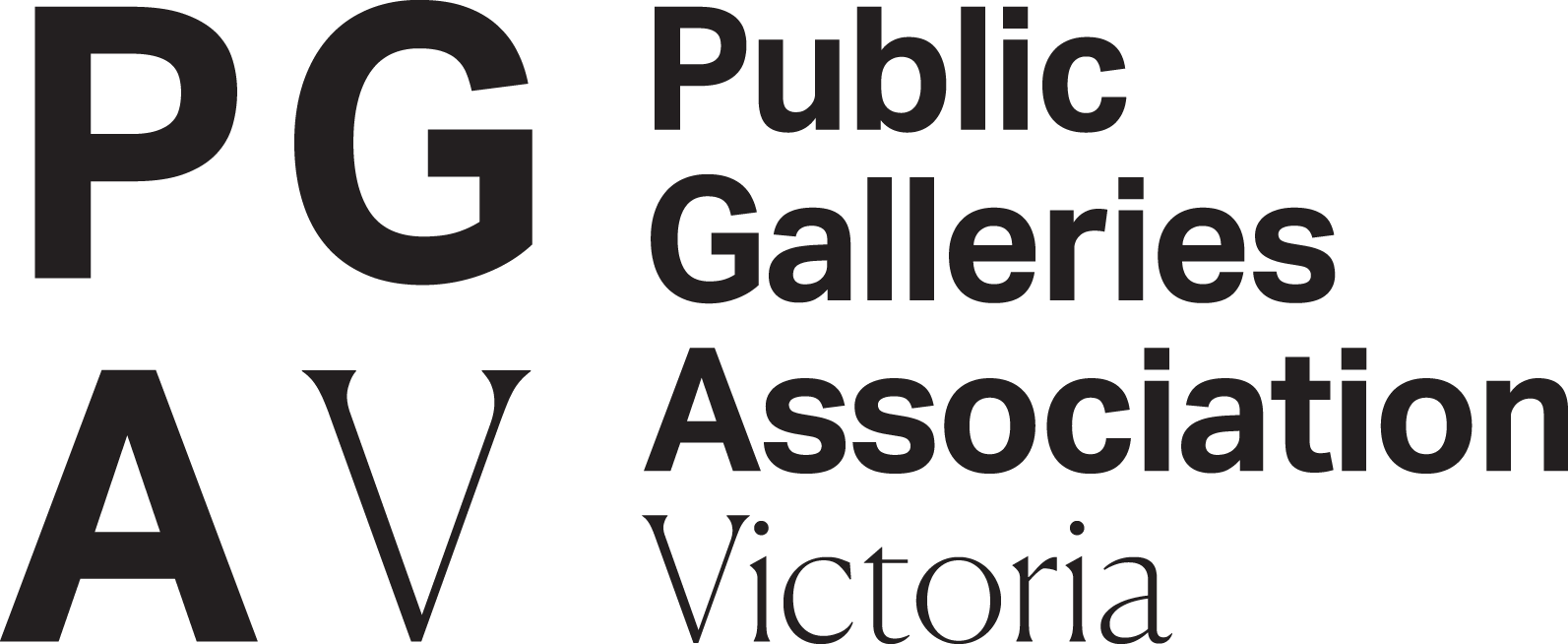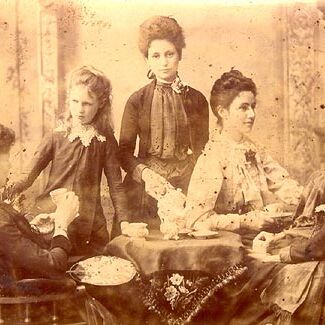
May Vale
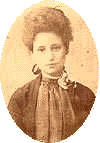
Private Collection
This special series of online newsletters celebrate the outstanding contribution of members, past and present, artists and events. This Newsletter features May Vale and her life with words provided by Art Historian Andrew Mackenzie OAM.
'Like Clara Southern and Jane Sutherland, May Vale was a strong fighter for the recognition of the professional standing of women artists, and along with Jane Sutherland, was one of the first women to be elected a member of the Buonarotti Society. This Society started in 1880, and May Vale is recorded as being elected as early as 1883.
May Vale also shared the distinction with Jane Sutherland of being one of the first two women to be elected to the Council of the Victorian Artists Society. This occurred in 1900, and she was again elected a Councillor in 1903-1904.'
May Vale

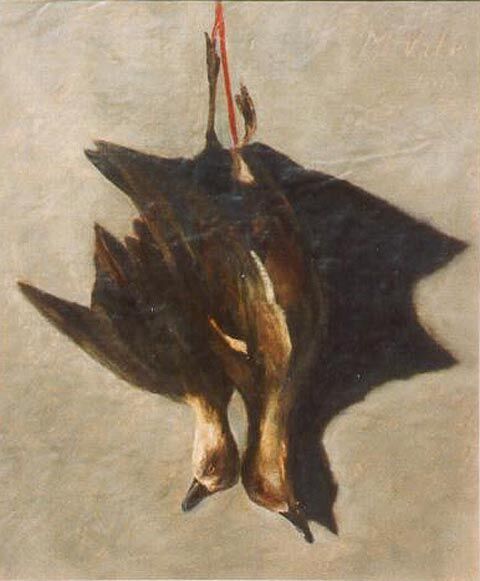
DUCKS (SHOT AT THE MERRI CREEK), 1884
This still life work of a pair of dead ducks and the shadow that they cast, was painted at a time that May Vale was a student in the School of Painting at the National Gallery School. Her teacher at this time was George Frederick Folingsby, and the work shows the strong influence of Folingsby's teaching.

PORTRAIT OF DAVID SYME, c. 1892
This portrait of David Syme reading a newspaper, was painted on board ship in 1892, while May Vale was on her return voyage from Europe.
David Syme, was the proprietor of The Age newspaper He was born on 2 October 1827 at North Berwick, Scotland and died at his home 'Blythswood' in Kew, Victoria on 14 February 1908.
In his biography in the Australian Dictionary of Biography, Syme is described as 'slim, six feet in height, with deep-set eyes, a thin straight mouth and iron-grey hair and beard, grim and gaunt in appearance, smiling rarely'.
At the time of this portrait, he would have been around sixty-five years of age.
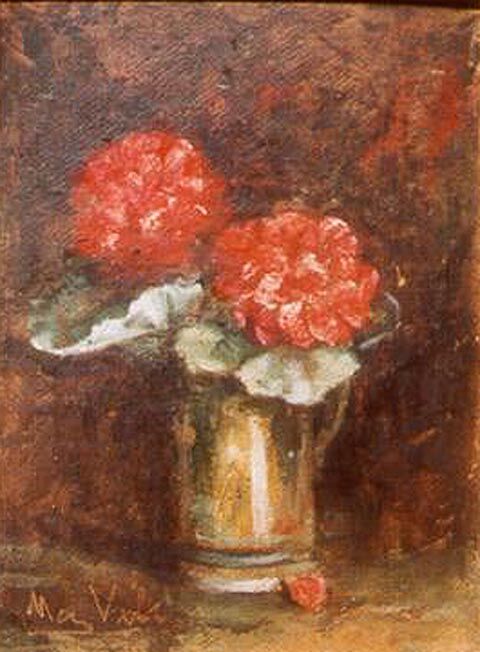
GERANIUMS
May Vale, produced a number of small flower studies in oils, and in this work she has captured the light on the Geraniums and their petals, the brightness of the blooms, and the reflection of the light on the brass vessel in which they stand.. She loved her garden, and in the 1920's, grew many flowers around her hilltop studio and hut, 'The Shack' in Diamond Creek.
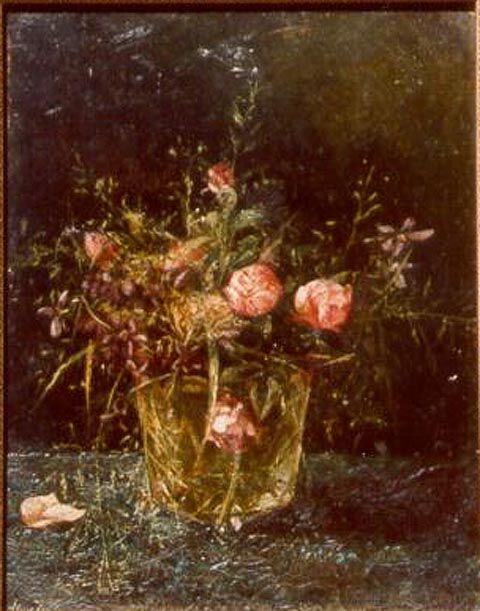
ROSES IN CRYSTAL VASE
In this small oil work, May Vale, exhibits her skill in depicting the translucency of the crystal vase. It is a difficult subject to master, and one that may have been set as a student exercise at the National Gallery School.
Arthur Streeton was one of the few artists who excelled in this area, and painted many works in his later years, of the roses from his garden, in crystal vases.
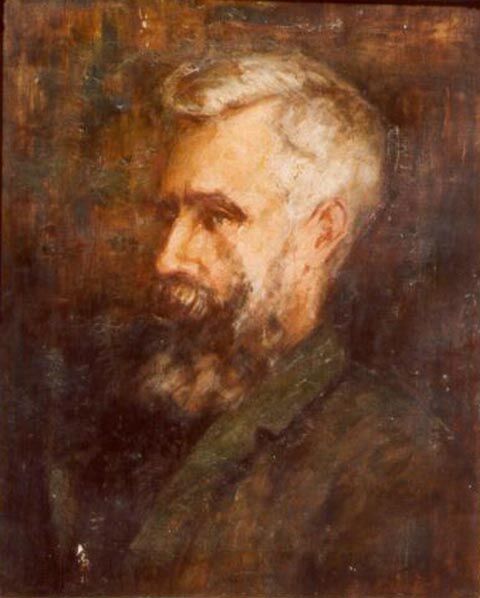
PORTRAIT OF THE ARTIST'S FATHER, WILLIAM MOUNTFORD KINSEY VALE
William Mountford Kinsey Vale, was born 10 August 1833, and died from Bright's disease at Collingwood on 23 October 1895. He is buried in St. Kilda Cemetery. He had a very successful career in politics, holding the seats of Ballarat West, Collingwood and Fitzroy, at various times of his life.
At his funeral a small black booklet was given to those attending, written by R.R. and re-printed from a Ballarat Paper, October 1895. This was AN APPRECIATION : THE LATE Hon. William M.K.Vale, and it told of Vale's early years in the political arena of Ballarat. Further references to W.M.K.Vale, and his brother, Richard Tayler Vale, who was also a politician in Ballarat West, can be found in
The History of Ballarat: From the First Pastoral Settlement to the Present Time
by William Bramwell Withers, Ballarat, F.W.Niven, 1887; and in Lucky City: The First Generation at Ballarat, 1851-1901 by Weston Bate, Carlton South, Melbourne University Press, 1978. He is also referred to in all other major histories of Ballarat, as well as early histories of Collingwood.
Vale was also a land speculator, in areas such as Mount Eliza, and Mornington, and lost his fortune in the land boom crash of the early 1890's.
Joy E. Parnaby, in her Australian Dictionary of Biography entry on W.M.K.Vale, noted that Alfred Deakin, described him as 'handsome, well-featured, with fine eyes and a ringing mellow voice, abounding in energy, voluble, fairly well-read and a strict Puritan in life and ideals, strong in domestic affections…His faults were an egotism which made him envious and suspicious, a biliousness which made him intolerant and vindictive and a vocabulary which made him a master of personal abuse'.

Andrew Mackenzie OAM
Art Historian
AN INSIGHT INTO MAY VALE'S LIFE AND HER ART BY LEADING ART HISTORIAN ANDREW MACKENZIE OAM
"May Vale, artist, teacher and enameler, was born on 18 November 1862 at Ballarat, Victoria. She was the third of eleven children, and the second eldest daughter of six daughters and five sons of William Mountford Kinsey Vale, stationer, barrister, politician and land speculator, and Rachel Vale, nee Lennox, both born in London.
Her parents married in London in 1859, and soon after returned to Victoria, where William Vale had resided since 1853. Settling once again in Ballarat, William Vale represented Ballarat West in the 1860's, before moving to Melbourne, where he became MLA for Collingwood from October 1869 to March 1874.
The following birth dates and places of birth of the Vale children, give us some indication of May Vale's whereabouts in these early years of her life.
The eleven children in the family, were: Grace, born Ballarat, 1860; William Mornington, born Ballarat, 1861; May, born Ballarat, 1862; Harry Blake, born Ballarat, 1864; John Bright, born Ballarat, 1866; William Richard Kinsey, born Ballarat, 1868; Rachel Elizabeth, born St. Kilda, 1870; Elsie, born St. Kilda, 1872; Beatrice, born St. Kilda, 1874; John Stone Fowler, born Ballarat, 1876; and Faith, born Fitzroy, 1879.
The family birth dates and places of birth would indicate that the Vale family moved from Ballarat in the late 1860's and moved to St. Kilda, where Rachel Elizabeth was born in 1870. May, attended the nearby Honiton College in St. Kilda, and late in 1874, travelled with her family to London, where her father had been offered a position as a member of the Board of Advice to the Agent-General. Records would indicate that May went to school in London, and also enrolled in the Royal School of Art at South Kensington to 1878. She then travelled back to Melbourne with her father, who had qualified as a barrister in 1878, and who in 1879, was admitted to the Victorian Supreme Court. The birth of May's brother, John Stone Fowler, in Ballarat in 1876, I suggest would indicate, that her mother, once realising she was pregnant, decided to return from London before her husband, and reside with her husband's brother, Richard Tayler Vale, in Ballarat.
On her return from London, the family moved from St. Kilda to Fitzroy, where her sister, Faith was born in 1879. May was fortunate that her father enthusiastically supported her interest in becoming a professional artist. He was a keen supporter of the Arts, and was a Trustee of the Public Library, Museums, and National Gallery from 1872 to 1895.
In 1879, May enrolled in the National Gallery School, and it is likely that she studied in the School of Design, under Oswald Rose Campbell, and later in the School of Painting, under George Frederick Folingsby. She remained at the National Gallery Schools until 1889, with a short break in the first half of 1886 and a break from studies in 1887.
In 1884, she was enrolled in the School of Painting with Jane Sutherland, and in the following year, was enrolled with Jane Sutherland and Clara Southern. In 1886, she enrolled in the School of Painting, only for the second half of the year, and missing 1887, enrolled once again in the School of Painting in 1888 and 1889.
One of the works she produced while a student in the School of Painting, was her still life 'Ducks (Shot at Merri Creek)', 1884. Merri Creek was a popular location for artists as well as shooters, and was painted by Julian Ashton in 1882 in his work 'Evening - Merri Creek', on the verso of which, he questionably claims that this is 'The first landscape painted out-of-doors in Australia'. May Vale painted a number of other still life works, amongst which are the small oil canvasses
'Geraniums' and 'Roses in Crystal Vase'.
May Vale was also interested in painting out-of-doors, or plein air, and this interest was further heightened after a study tour of Italy, London and Paris, which commenced in 1890. While in London, she studied watercolour under Sir James D. Linton, President of the Royal Society of Watercolour Painters. She then travelled to Paris, where she studied for six months at the Academie Julian, under Jules Lefebvre and Tony Robert-Fleury.
In 1892, May Vale returned to Melbourne, and on her return, while aboard ship, she painted her 'Portrait of David Syme', c. 1892.
Arriving in Melbourne, she settled at the family home 'Mayfield', 37 Church Street, Abbotsford, which her father had purchased in 1886. 'Mayfield' was the house built for Andrew and Georgiana McCrae in 1841-42, and it was here, soon after her return from overseas, that May Vale gave her first art lesson. She also opened a studio in the city at 119 Swanston Street, where she advertised herself as 'artist and portrait painter', and took on several commissions as well as giving art classes from 1893.
Her father died in October 1895, after losing much of his wealth in the financial and land boom crash of the early 1890's, and this very much meant that financially from this time that May Vale had to fend for herself. She moved to a studio in Flinders Buildings, and here she continued with her teaching. She established her own art school, taking students on plein air painting excursions. This venture was profitable for May Vale, and the school attracted many students. Among her students was Alice Bale, who also enrolled at the National Gallery Schools between 1895 and 1904.
Her own works at this time included a number of still life canvases, a good example of which is her work 'Sea Jewels', 1897.
Like Clara Southern and Jane Sutherland, May Vale was a strong fighter for the recognition of the professional standing of women artists, and along with Jane Sutherland, was one of the first women to be elected a member of the Buonarotti Society. This Society started in 1880, and May Vale is recorded as being elected as early as 1883.
May Vale also shared the distinction with Jane Sutherland of being one of the first two women to be elected to the Council of the Victorian Artists' Society. This occurred in 1900, and she was again elected a Councillor in 1903-1904.
She was also a Foundation Member in 1898 of the Yarra Sculptors' Society, and was a Councillor of this Society in 1901-1902.
In 1902, she moved into a studio in Elizabeth Street, Melbourne, and exhibited a number of significant works with the Yarra Sculptors' Society.
Around 1904, she painted her major work 'The Orchard', c. 1904, which is a nostalgic work, in which she depicts the 'old family home', 'Mayfield', and one which shows the strong influence of the Barbizon School in France. She also produced a small preparatory oil sketch of 'The Orchard', which she titled in bold print in the lower left-hand corner of this work 'OLD MAYFIELD'. 'The Orchard' was shown in the
Victorian Artists' Society Exhibition, July 1904. Catalogue no. 145, price 16 guineas.
She also produced in 1904 a number of black and white sketches of the seaside at Williamstown, and one of these is dated 15.4.1904.
In a letter from Frederick McCubbin to Tom Roberts dated 25 August 1905, McCubbin writes that Miss Vale's heart is 'intent on Europe' - and that he 'saw her off the other day'. She left for London in 1905, and arriving there visited Tom Roberts. Tom Roberts in a letter to Frederick McCubbin, dated 18 February 1907, wrote that 'Miss Vale is remaining in Chelsea'.
While she was away in London, in November 1905, Frederick McCubbin's wife, Annie organized a Private Exhibition in her husband's studio and three rooms of their house in Shipley Street, South Yarra. In this exhibition, works by May Vale were shown alongside works by other Heidelberg School women artists, including Clara Southern, Jane Price and Jane Sutherland.
Also, while she was away, she was represented in the First Exhibition of Australian Women's Work held in the Exhibition Buildings, Melbourne in 1907. In this exhibition her work 'The Orchard' was shown, and was now priced at 78 pounds 15 shillings. She also had work accepted for exhibition with the Victorian Artists' Society in 1908.
In London, she studied enameling, jewellery and metal work at the Polytechnic in Chelsea, and attended life classes at Burbeck Institute. She later visited Paris and briefly studied at the Academie Julian.
On 20 August 1908, she married Alexander Gilfillan at the Registry-Office in Chelsea. He was a mining engineer, who had known May since her teenage years, when they both attended the same Congregational Church. It was, by all accounts, an unusual marriage, for it is recorded that only a few hours after the service, Gilfillan left 'on some distant safari', and never returned. However, he did keep in touch with May, sending her letters and presents from various exotic locations where he worked as an engineer.
May returned to Melbourne in 1909, and established a studio in Oxford Chambers. Here she further developed her metal work and enameling skills. She exhibited her artworks in 1909 and 1910, and exhibited her first enamel works with the Yarra Sculptors' Society. Her enamel works also included large Greek and Egyptian style vases. It has been recorded that she 'rightly claimed to be a pioneer of Australian landscape and portraits in enamel', and was considered by many to be a talented portraitist.
She produced portraits over many years, including a number of portraits of members of her family. Two of the known portraits are of her sister, Faith. One is titled 'Girl Reading', c. 1890, and a later one of Faith is titled 'Faith learning her lesson', 1898. She also produced portraits of her parents, with the works 'Portrait of the Artist's Father, William Mountford Kinsey Vale' and 'Portrait of the Artist's Mother, Rachel Vale, nee Lennox'
May Vale held exhibitions of her works at the Victorian Artists' Society in 1915, and Besant Hall in 1916. Also in 1916, she travelled to the Illawarra and South Coast region of New South Wales. She returned in 1917 and exhibited the works she had produced on her travels. These were mostly small oil panels.
In 1918, she exhibited for the first time with the Women's Art Club, and apart from 1922, throughout the 1920's, she exhibited at the Athenaeum. She also continued to exhibit her works in her studio in Oxford Chambers, where she also continued to give art classes and produce her enamel works. These enamel works were highly sought after, and provided a steady income, with interest in these works from collectors throughout Australia.
In 1927, the May Vale Solo Exhibition was held in the Queens Hall.
In the 1920's, she settled in Diamond Creek, where she created a hilltop studio, which she named 'The Shack'. Here she continued with her small enamel works, although by the 1930's her worsening arthritis and cataracts made it very difficult for her to continue with even these small works.
Late in the 1930's she went to live with family members at her brother's house in Black Rock. In a letter of 24 March 1939, she writes to various family members from this Black Rock house, where the address is given as 15 Ardoyne Street. It is recorded that she held two exhibitions at this Black Rock address during the Second World War.
Her husband died in Singapore in July 1940.
During her lifetime, she developed strong friendships with her fellow women artists as well as close friendships with her male colleagues, especially Frederick McCubbin and Tom Roberts.
She was very much the professional artist, as well as being very interested in the women's movement. She became an active member of the Victorian Women's Suffrage Society, and was outspoken on the rights of women.
She has been described as having 'brown hair and eyes, and was an independent person, outgoing and animated'.
She died on 6 August 1945, at eighty-two years of age, at Black Rock, and was buried at Cheltenham Cemetery."
The Victorian Artists Society
With the Victorian Artists Society closed at present due the COVID-19 pandemic, the online newsletters are continuing to celebrate the outstanding contribution of members, past and present, artists and events. The current newsletters are focusing on the important contribution made by the women artists of the Heidelberg School to our society.
This Newsletter features May Vale and her life with words provided by Art Historian Andrew Mackenzie OAM.
"Like Clara Southern and Jane Sutherland, May Vale was a strong fighter for the recognition of the professional standing of women artists, and along with Jane Sutherland, was one of the first women to be elected a member of the Buonarotti Society. This Society started in 1880, and May Vale is recorded as being elected as early as 1883.
May Vale also shared the distinction with Jane Sutherland of being one of the first two women to be elected to the Council of the Victorian Artists Society. This occurred in 1900, and she was again elected a Councillor in 1903-1904."
Media Enquiries:
Ron Smith OAM Hon FVAS, Victorian Artists Society - Mobile: 0417 329 201
Acknowledgment of traditional owners.
We would like to pay our respects to the traditional owners of the land on which our building stands, their leaders, past, present and emerging.

